Extreme Precipitation Strongly Impacts the Interaction of Skewness and Kurtosis of Annual Precipitation Distribution on the Qinghai–Tibetan Plateau
Abstract
1. Introduction
2. Materials and Methods
2.1. The Relationship between Skewness and Kurtosis
2.2. Effects of Precipitation Extremes on Skewness and Kurtosis
2.3. The Response of Skewness–Kurtosis Interactions to Precipitation Extremes
3. Results
3.1. The Relationship between Skewness and Kurtosis of Annual Precipitation
3.2. Effects of Precipitation Extremes on Skewness and Kurtosis of Annual Precipitation
3.3. Response of Skewness–Kurtosis Interactions to Precipitation Extremes
4. Discussion
5. Conclusions
Funding
Institutional Review Board Statement
Informed Consent Statement
Data Availability Statement
Acknowledgments
Conflicts of Interest
Appendix A
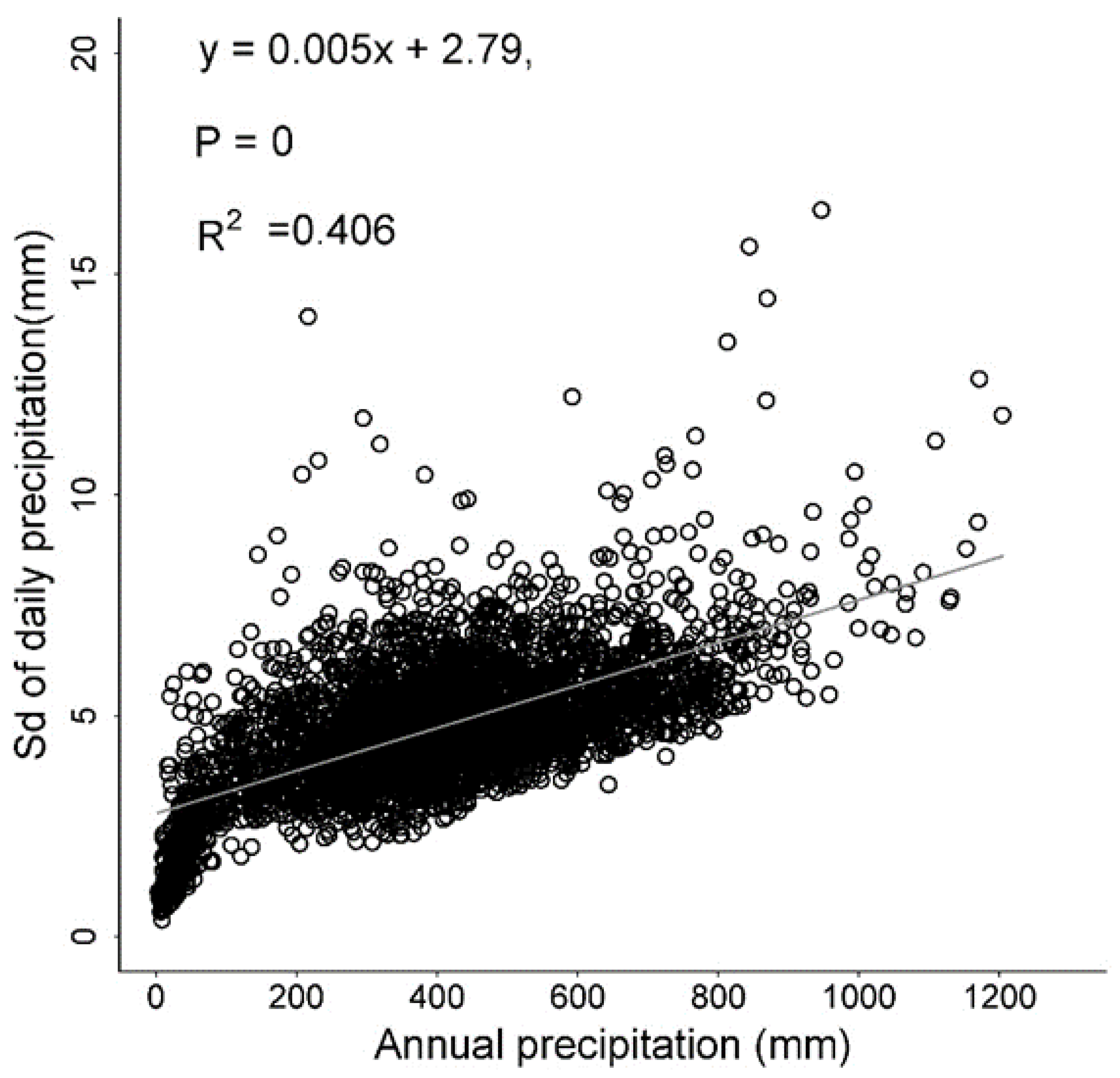

References
- Intergovernmental Panel on Climate Change (IPCC). Managing the Risks of Extreme Events and Disasters to Advance Climate Change Adaptation: Special Report of the Intergovernmental Panel on Climate Change; Cambridge University Press: Cambridge, UK; New York, NY, USA, 2012. [Google Scholar]
- Alexander, L.V.; Zhang, X.; Peterson, T.C.; Caesar, J.; Gleason, B.; Tank, A.M.G.K.; Haylock, M.; Collins, D.; Trewin, B.; Rahimzadeh, F.; et al. Global observed changes in daily climate extremes of temperature and precipitation. J. Geophys. Res. Atmos. 2006, 111, D05109. [Google Scholar] [CrossRef]
- Faiz, M.A.; Liu, D.; Fu, Q.; Wrzesinski, D.; Baig, F.; Nabi, G.; Khan, M.I.; Li, T.X.; Cui, S. Extreme precipitation and drought monitoring in northeastern China using general circulation models and pan evaporation-based drought indices. Clim. Res. 2018, 74, 231–250. [Google Scholar] [CrossRef]
- Sunyer, M.A.; Luchner, J.; Onof, C.; Madsen, H.; Arnbjerg-Nielsen, K. Assessing the importance of spatio-temporal RCM resolution when estimating sub-daily extreme precipitation under current and future climate conditions. Int. J. Climatol. 2017, 37, 688–705. [Google Scholar] [CrossRef]
- Ummenhofer, C.C.; Meehl, G.A. Extreme weather and climate events with ecological relevance: A review. Philos. Trans. R. Soc. B 2017, 372, 20160135. [Google Scholar] [CrossRef]
- Stott, P. How climate change affects extreme weather events Research can increasingly determine the contribution of climate change to extreme events such as droughts. Science 2016, 352, 1517–1518. [Google Scholar] [CrossRef]
- Marelle, L.; Myhre, G.; Hodnebrog, O.; Sillmann, J.; Samset, B.H. The Changing Seasonality of Extreme Daily Precipitation. Geophys. Res. Lett. 2018, 45, 11352–11360. [Google Scholar] [CrossRef]
- Knapp, A.K.; Beier, C.; Briske, D.D.; Classen, A.T.; Luo, Y.; Reichstein, M.; Smith, M.D.; Smith, S.D.; Bell, J.E.; Fay, P.A.; et al. Consequences of More Extreme Precipitation Regimes for Terrestrial Ecosystems. Bioscience 2008, 58, 811–821. [Google Scholar] [CrossRef]
- Palmer, T.N.; Ralsanen, J. Quantifying the risk of extreme seasonal precipitation events in a changing climate. Nature 2002, 415, 512–514. [Google Scholar] [CrossRef]
- Holmgren, M.; Stapp, P.; Dickman, C.R.; Gracia, C.; Graham, S.; Gutiérrez, J.R.; Hice, C.; Jaksic, F.; Kelt, D.A.; Letnic, M.; et al. Extreme climatic events shape arid and semiarid ecosystems. Front. Ecol. Environ. 2006, 4, 87–95. [Google Scholar] [CrossRef]
- Smith, M.D. An ecological perspective on extreme climatic events: A synthetic definition and framework to guide future research. J. Ecol. 2011, 99, 656–663. [Google Scholar] [CrossRef]
- van de Pol, M.; Jenouvrier, S.; Cornelissen, J.H.C.; Visser, M.E. Behavioural, ecological and evolutionary responses to extreme climatic events: Challenges and directions. Philos. Trans. R. Soc. B 2017, 372, 20160134. [Google Scholar] [CrossRef]
- Easterling, D.R.; Meehl, G.A.; Parmesan, C.; Changnon, S.A.; Karl, T.R.; Mearns, L.O. Climate extremes: Observations, modeling, and impacts. Science 2000, 289, 2068–2074. [Google Scholar] [CrossRef]
- Xiao, M.Z.; Zhang, Q.; Singh, V.P. Spatiotemporal variations of extreme precipitation regimes during 1961–2010 and possible teleconnections with climate indices across China. Int. J. Clim. 2017, 37, 468–479. [Google Scholar] [CrossRef]
- Dwyer, J.G.; O’Gorman, P.A. Changing duration and spatial extent of midlatitude precipitation extremes across different climates. Geophys. Res. Lett. 2017, 44, 5863–5871. [Google Scholar] [CrossRef]
- Tank, A.M.G.K.; Peterson, T.C.; Quadir, D.A.; Dorji, S.; Zou, X.; Tang, H.; Santhosh, K.; Joshi, U.R.; Jaswal, A.K.; Kolli, R.K.; et al. Changes in daily temperature and precipitation extremes in central and south Asia. J. Geophys. Res. Atmos. 2006, 111, D16105. [Google Scholar] [CrossRef]
- Zhang, J.S.; Shen, X.J.; Wang, B.L. Changes in precipitation extremes in Southeastern Tibet, China. Quat. Int. 2015, 380, 49–59. [Google Scholar] [CrossRef]
- Ge, G.; Shi, Z.J.; Yang, X.H.; Hao, Y.G.; Guo, H.; Kossi, F.; Xin, Z.M.; Wei, W.; Zhang, Z.Y.; Zhang, X.; et al. Analysis of Precipitation Extremes in the Qinghai-Tibetan Plateau, China: Spatio-Temporal Characteristics and Topography Effects. Atmosphere 2017, 8, 127. [Google Scholar] [CrossRef]
- Guo, T. Long-Term Changes and Variability of Ecologically-Based Climate Indices along an Altitudinal Gradient on the Qinghai-Tibetan Plateau. Climate 2020, 9, 1. [Google Scholar] [CrossRef]
- You, Q.L.; Kang, S.C.; Aguilar, E.; Yan, Y.P. Changes in daily climate extremes in the eastern and central Tibetan Plateau during 1961–2005. J. Geophys. Res. Atmos. 2008, 113, D07101. [Google Scholar] [CrossRef]
- Guo, T.; Tang, Y. Beyond the Mean: Long-Term Variabilities in Precipitation and Temperature on the Qinghai–Tibetan Plateau. J. Appl. Meteorol. Climatol. 2021, 60, 829–838. [Google Scholar] [CrossRef]
- Gross, N.; Le Bagousse-Pinguet, Y.; Liancourt, P.; Saiz, H.; Violle, C.; Munoz, F. Unveiling ecological assembly rules from commonalities in trait distributions. Ecol. Lett. 2021, 24, 1668–1680. [Google Scholar] [CrossRef] [PubMed]
- Shen, S.S.P.; Wied, O.; Weithmann, A.; Regele, T.; Bailey, B.A.; Lawrimore, J.H. Six temperature and precipitation regimes of the contiguous United States between 1895 and 2010: A statistical inference study. Theor. Appl. Clim. 2016, 125, 197–211. [Google Scholar] [CrossRef]
- Guo, T.; Tang, Y.H. Considering Effects of Climate Extremes on Plant Functional Traits Benefits the Prediction of Ecosystem Functioning. Appl. Ecol. Environ. Res. 2019, 17, 10091–10104. [Google Scholar] [CrossRef]
- Li-Ge, C.; Jun, Z.; Bu-Da, S.; Jian-Qing, Z.; Gemmer, M. Probability Distribution and Projected Trends of Daily Precipitation in China. Adv. Clim. Change Res. 2013, 4, 153–159. [Google Scholar] [CrossRef]
- Wang, S.J.; Zhang, M.J.; Wang, B.L.; Sun, M.P.; Li, X.F. Recent changes in daily extremes of temperature and precipitation over the western Tibetan Plateau, 1973–2011. Quat. Int. 2013, 313, 110–117. [Google Scholar] [CrossRef]
- Grimm, A.M. Interannual climate variability in South America: Impacts on seasonal precipitation, extreme events, and possible effects of climate change. Stoch. Environ. Res. Risk Assess. 2011, 25, 537–554. [Google Scholar] [CrossRef]
- Sanchez-Gomez, E.; Terray, L.; Joly, B. Intra-seasonal atmospheric variability and extreme precipitation events in the European-Mediterranean region. Geophys. Res. Lett. 2008, 35, L15708. [Google Scholar] [CrossRef]
- Nie, J.; Dai, P.; Sobel, A.H. Dry and moist dynamics shape regional patterns of extreme precipitation sensitivity. Proc. Natl. Acad. Sci. USA 2020, 117, 8757–8763. [Google Scholar] [CrossRef]
- Donat, M.G.; Angélil, O.; Ukkola, A.M. Intensification of precipitation extremes in the world’s humid and water-limited regions. Environ. Res. Lett 2019, 14, 065003. [Google Scholar] [CrossRef]
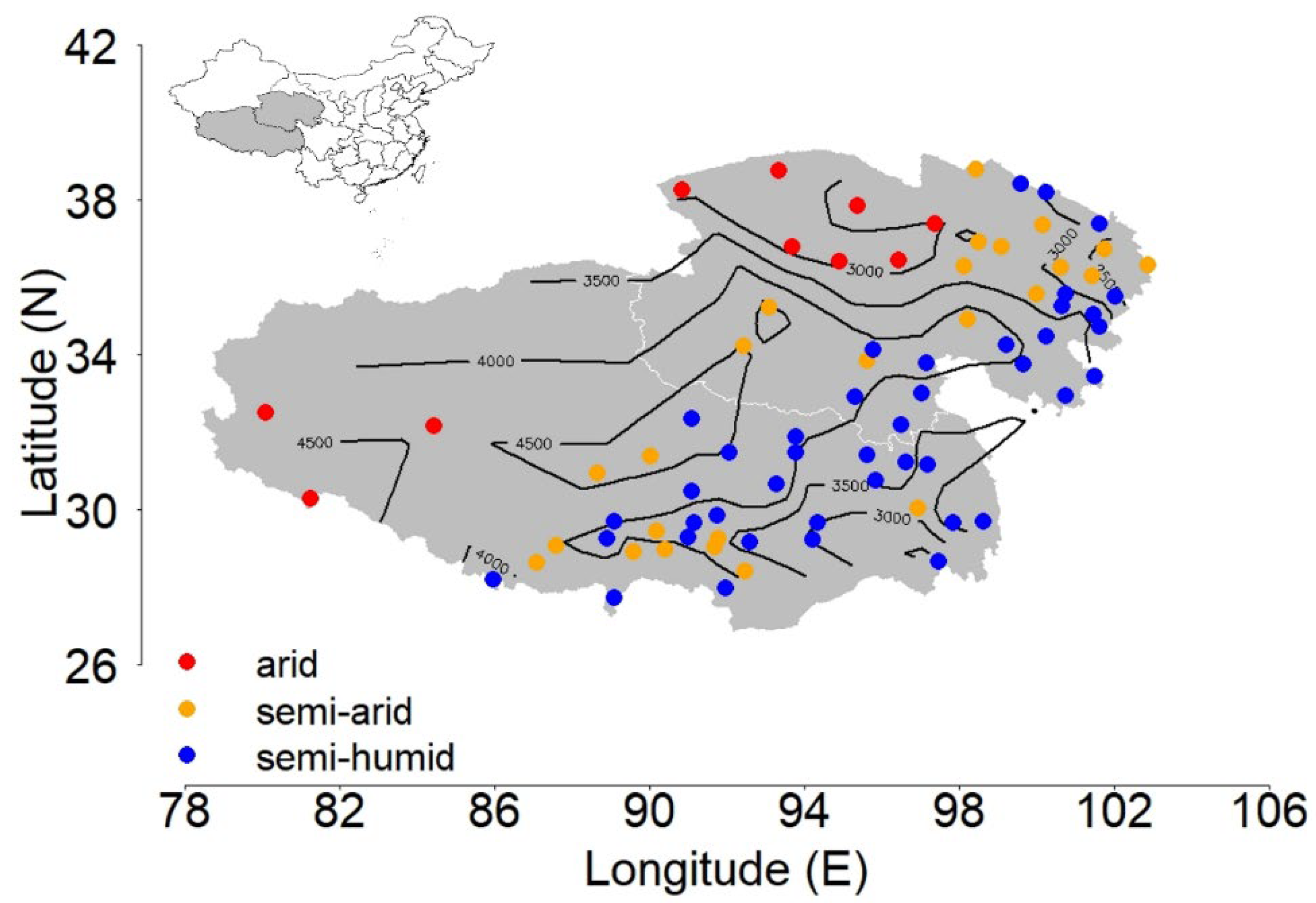
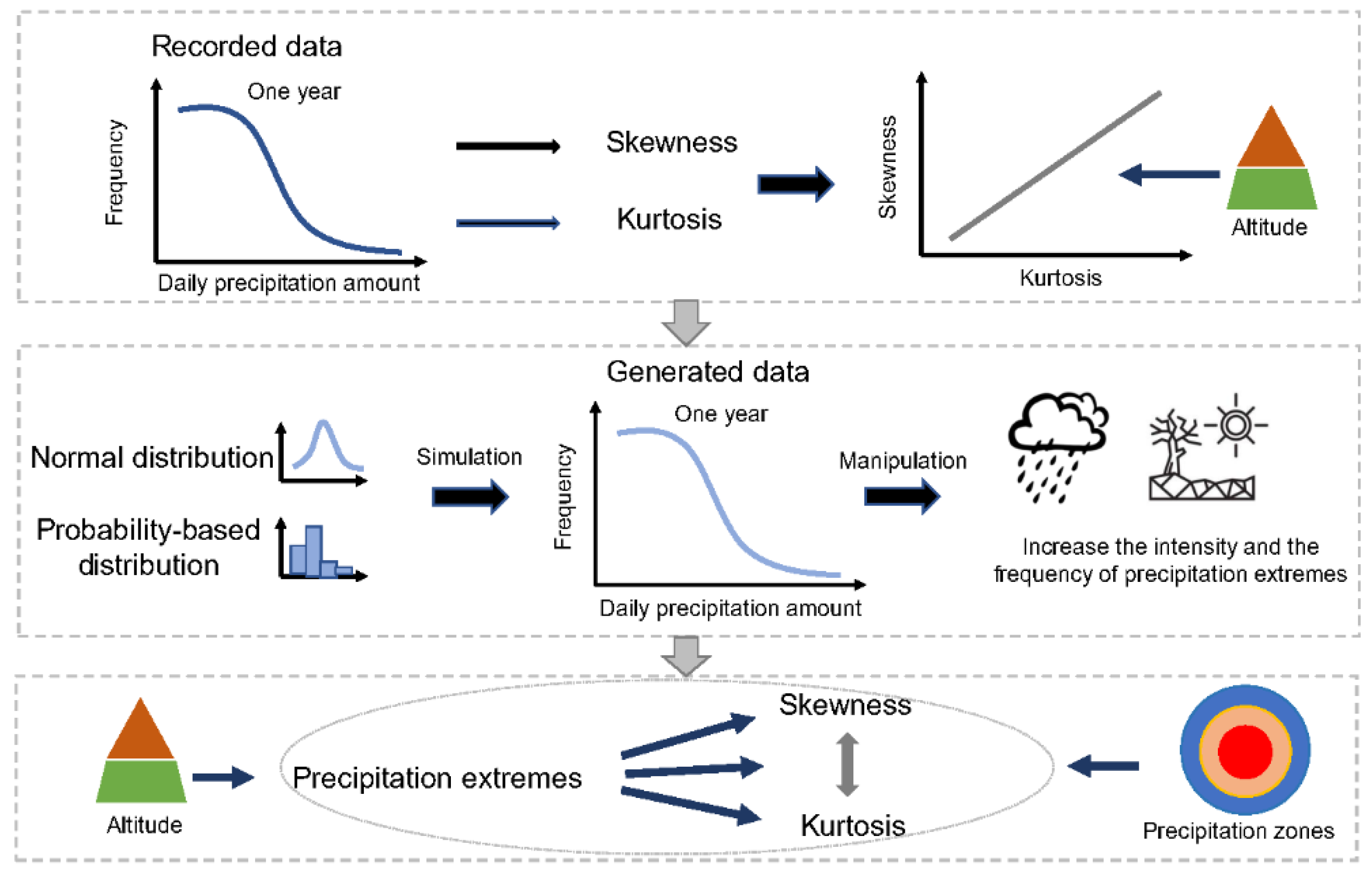
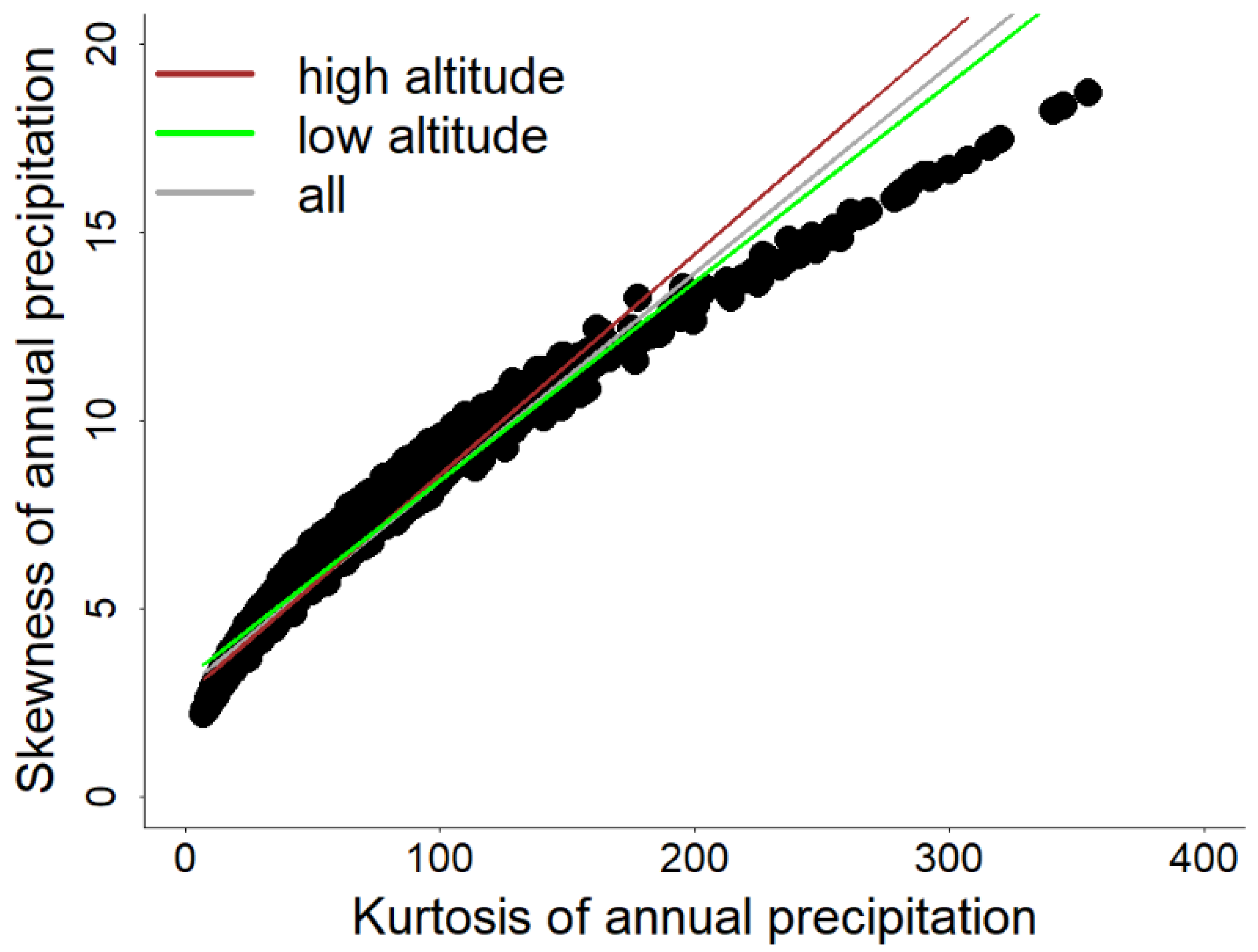
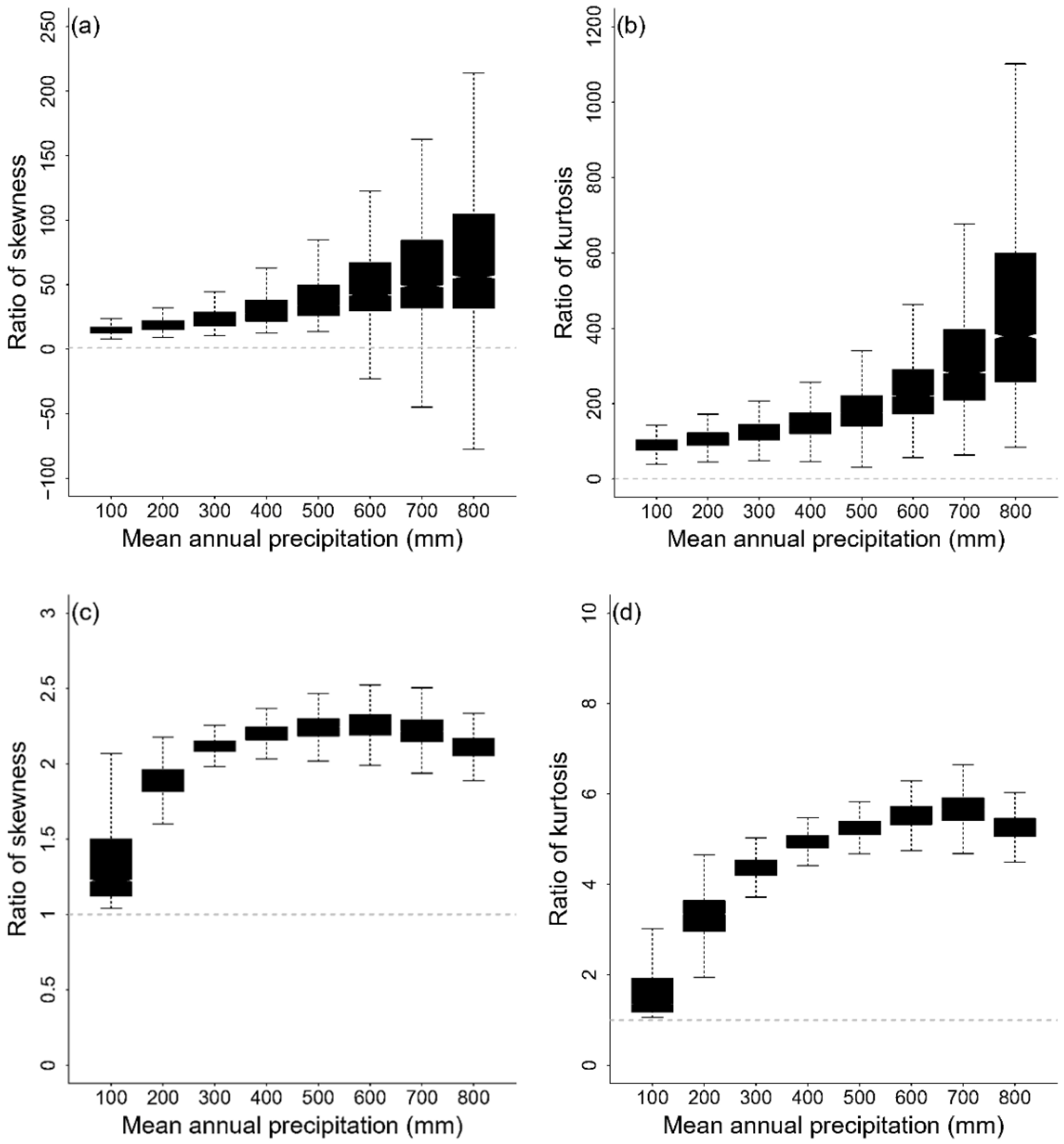
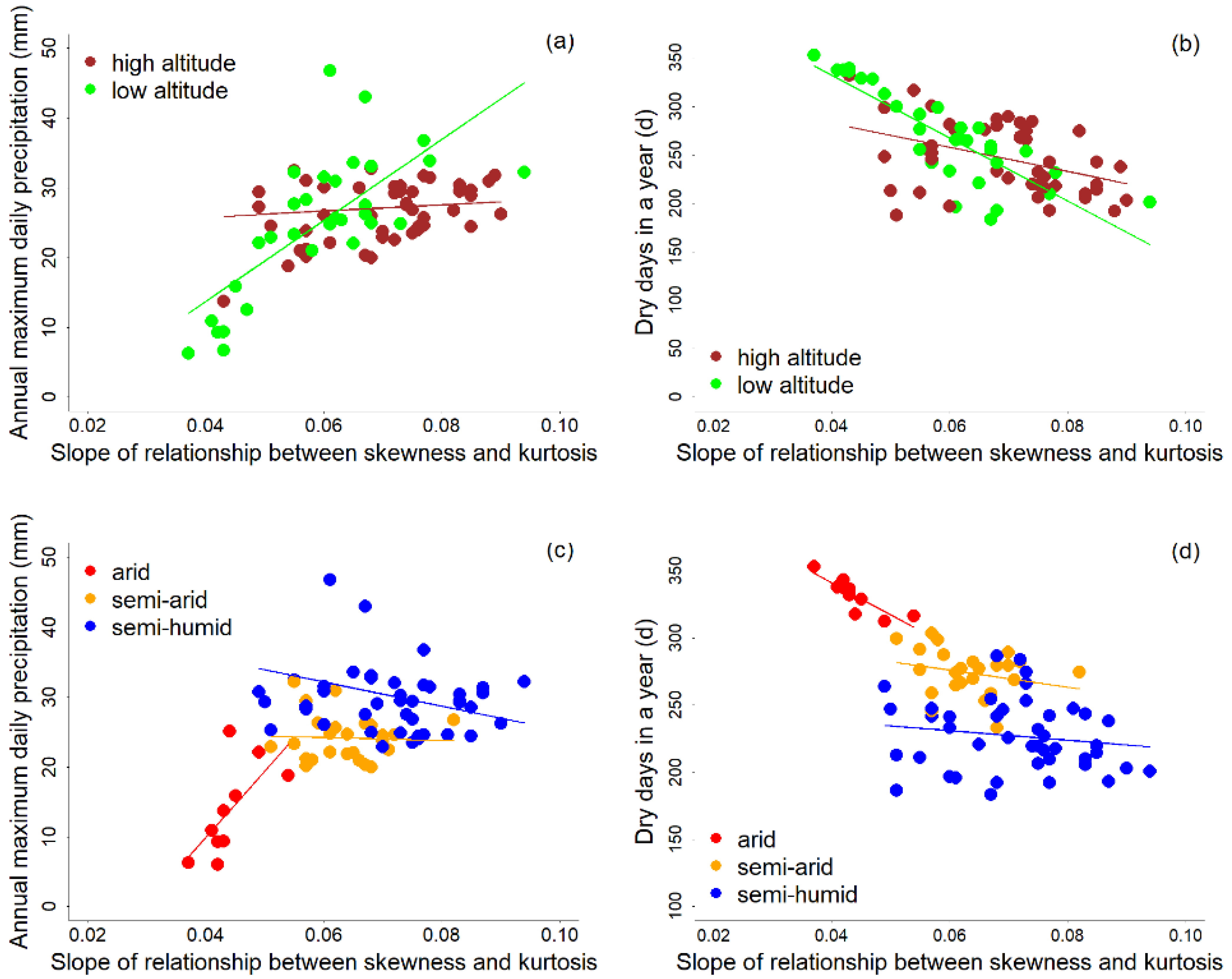
Publisher’s Note: MDPI stays neutral with regard to jurisdictional claims in published maps and institutional affiliations. |
© 2022 by the author. Licensee MDPI, Basel, Switzerland. This article is an open access article distributed under the terms and conditions of the Creative Commons Attribution (CC BY) license (https://creativecommons.org/licenses/by/4.0/).
Share and Cite
Guo, T. Extreme Precipitation Strongly Impacts the Interaction of Skewness and Kurtosis of Annual Precipitation Distribution on the Qinghai–Tibetan Plateau. Atmosphere 2022, 13, 1857. https://doi.org/10.3390/atmos13111857
Guo T. Extreme Precipitation Strongly Impacts the Interaction of Skewness and Kurtosis of Annual Precipitation Distribution on the Qinghai–Tibetan Plateau. Atmosphere. 2022; 13(11):1857. https://doi.org/10.3390/atmos13111857
Chicago/Turabian StyleGuo, Tong. 2022. "Extreme Precipitation Strongly Impacts the Interaction of Skewness and Kurtosis of Annual Precipitation Distribution on the Qinghai–Tibetan Plateau" Atmosphere 13, no. 11: 1857. https://doi.org/10.3390/atmos13111857
APA StyleGuo, T. (2022). Extreme Precipitation Strongly Impacts the Interaction of Skewness and Kurtosis of Annual Precipitation Distribution on the Qinghai–Tibetan Plateau. Atmosphere, 13(11), 1857. https://doi.org/10.3390/atmos13111857






